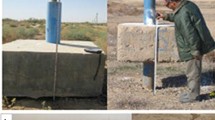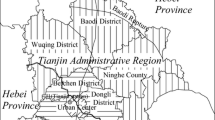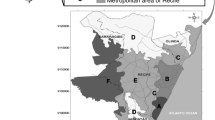Abstract
The artificial recharge is a technique of aquifer conservation for land subsidence. But in this article, the phenomenon of land subsidence and the resulting cracks and fissures at the study area are formed in recharge ponds. This is a new phenomenon and in this research the geometrical properties of the fissures of recharge ponds are measured. The results reveal the existence of fine layers in the geology of the aquifer, which are displaced in the long run as the consequence of groundwater overdraft. At the site of the artificial recharge subject of this research, the difference between the quality of recharge water and the aquifer and their interaction have intensified the instability and the movement of the fine sediments. In addition, the neglect of hydraulic principles of the groundwater during the construction and operation of the recharge wells has resulted in turbulent and speed flows, intensified displacement of fine sediments and ultimately the localized subsidence at the site of the plan.











Similar content being viewed by others
References
Arun Yadav, Abhijit Sonje, Priyanka Mathur and Jain D A 2012 A review on artificial groundwater recharge; Int. J. Pharm. Biosci. 3 (3) 304–311.
Bhattacharya Amartya Kumar 2010 Artificial groundwater recharge with a special reference to India; IJRRAS 4 (2) 214–221.
Herman Bouwer 1997 Land subsidence and cracking due to groundwater depletion; Groundwater 15 (5) 358–364, doi: 10.1111/j.1745-6584.1977.tb03180.x.
Herman Bouwer 2002 Artificial recharge of groundwater hydrogeology and engineering; Hydrogeol. J. 10 121–142, doi: 10.1007/s10040-001-0182-4.
Huisman L and Olsthoon T N 1982 Artificial groundwater recharges; Pitman Advanced Publishing Program, London, pp. 194–199.
Khorsandi A and Abdali M 2009 Sinkhole formation hazards, case study: Sinkholes hazard in Hamadan Plain and Lar Valley of Iran; Proceeding of the 6th Euregeo Congress, Munich, Germany, pp. 359–362.
Lewis R W and Schrefler B 1978 Fully coupled consolidation model of subsidence of Venice; Water Resour. Res. 14 (2) 223–230, doi: 10.1029/WR014i002p00223.
Mathewson C C 1981 Engineering geology, Charles E. Merrill Publ. Co., 410p.
Pewe Troy L 1990 Land subsidence and earth fissure formation caused by groundwater withdrawal in Arizona: A review; pp. 218–233, doi: 10.1130/SPE252-p219.
Poland J F and Davis G H 1969 Land subsidence due to withdrawal of fluids; In: Reviews in engineering geology; Geol. Soc. Am. Boulder 2 187–269.
Rostas Voudouris 2011 Artificial recharge via boreholes using treated wastewater: Possibilities and prospects; Water Journal 3 965–975, doi: 10.3390/w3040964.
Sadati G H and Mohamadi P 2004 The tectonics of Hamadan central plain subsidence holes; Proceeding of the Third Iranian Engineering Geology and Environment Conference; pp. 286-295.
Satish A Bhalerao and Tushar S Kelkar 2013 Artificial recharge of groundwater: A novel technique for replenishment of an aquifer with water from land surface; Int. J. Geol. Earth Environ. Sci. 3 165–183.
Waltman A C 1989 Ground subsidence, Blackie, 202p.
White W B and White E 1995 Thresholds for soil transport and the long stability of sinkholes.
Wilson William L and Beck Barry F 1992 Hydrogeologic factors in affecting new sinkhole development in the Orlando area, Florida; Ground Water 30 (6) 918–930, doi: 10.1111/j.1745-6584.1992.tb01575.x.
Author information
Authors and Affiliations
Corresponding author
Rights and permissions
About this article
Cite this article
AGHAI, A.K. Survey of land subsidence – case study: The land subsidence formation in artificial recharge ponds at South Hamadan Power Plant, northwest of Iran. J Earth Syst Sci 124, 261–268 (2015). https://doi.org/10.1007/s12040-014-0532-y
Received:
Revised:
Accepted:
Published:
Issue Date:
DOI: https://doi.org/10.1007/s12040-014-0532-y




